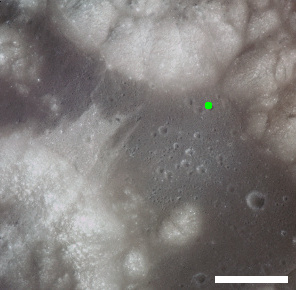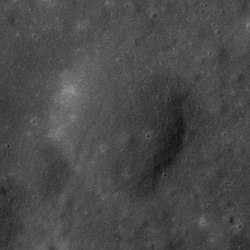
Ching-Te is a small lunar impact crater located in a mountainous area to the east of the Mare Serenitatis. It is a circular, bowl-shaped formation with no distinguishing features.

Taurus–Littrow is a lunar valley located on the near side at the coordinates 20.0°N 31.0°E. It served as the landing site for the American Apollo 17 mission in December 1972, the last crewed mission to the Moon. The valley is located on the southeastern edge of Mare Serenitatis along a ring of mountains formed between 3.8 and 3.9 billion years ago when a large object impacted the Moon, forming the Serenitatis basin and pushing rock outward and upward. Taurus–Littrow is located in the Taurus mountain range and south of Littrow crater, features after which the valley received its name. The valley's name, coined by the Apollo 17 crew, was eventually approved by the International Astronomical Union in 1973.
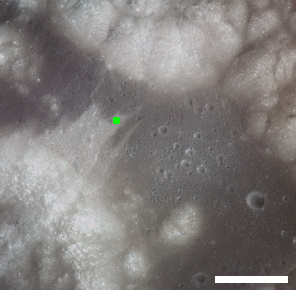
Shorty is a feature on Earth's Moon, a likely volcanic crater in the Taurus–Littrow valley. Astronauts Eugene Cernan and Harrison Schmitt visited it in 1972, on the Apollo 17 mission. It is the location of the famous "orange soil". It is about 110 meters in diameter and up to 14 m (15 yd) deep.
Shorty Crater is about 14 m deep. Based on our investigations at the site and later examination of photographs, the impact that formed it penetrated, in order, regolith on the avalanche deposit, the avalanche deposit, regolith on a basalt flow, a basalt flow overlying and protecting the orange and black glass layers, the orange and black glass layers, regolith on a second basalt flow, and, finally, the upper portion of that second flow. Orange and black glass clods and basalt boulders are spread throughout the ejecta blanket surrounding Shorty.
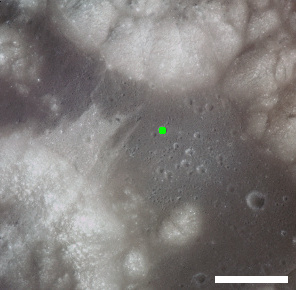
Camelot is a feature on Earth's Moon, a crater in Taurus-Littrow valley. Astronauts Eugene Cernan and Harrison Schmitt visited it in 1972, on the Apollo 17 mission, during EVA 2. Geology Station 5 was along the south rim of Camelot.

Brontë is a feature on Earth's Moon, a crater in Taurus-Littrow valley. The astronauts Eugene Cernan and Harrison Schmitt drove along the north rim of it in their Lunar Roving Vehicle on the Apollo 17 mission in 1972.

Victory is a feature on Earth's Moon, a crater in Taurus–Littrow valley. Astronauts Eugene Cernan and Harrison Schmitt visited it in 1972, on the Apollo 17 mission, during EVA 2. The astronauts stopped at the south rim of Victory on their way back to the Lunar Module from Shorty crater.
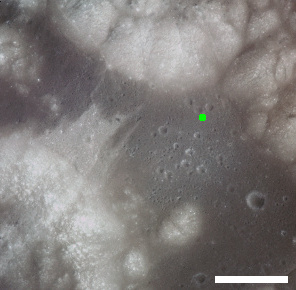
Van Serg is a feature on Earth's Moon, a crater in Taurus–Littrow valley. Astronauts Eugene Cernan and Harrison Schmitt visited it in 1972, on the Apollo 17 mission, during EVA 3. Van Serg was designated Geology Station 9.
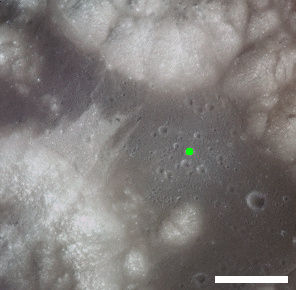
Steno-Apollo is a feature on Earth's Moon, a crater in Taurus-Littrow valley. Astronauts Eugene Cernan and Harrison Schmitt visited it in 1972, on the Apollo 17 mission. The astronauts referred to it simply as Steno during the mission. The north rim of Steno is Geology Station 1 of the mission.

Sherlock is a feature on Earth's Moon, a crater in Taurus–Littrow valley. Astronauts Eugene Cernan and Harrison Schmitt drove their rover to the north of it in 1972, on the Apollo 17 mission. They photographed the rim, as shown below.

Shakespeare is a feature on Earth's Moon, a crater in Taurus–Littrow valley. Astronauts Eugene Cernan and Harrison Schmitt landed southwest of it in 1972, on the Apollo 17 mission. They did not visit it, but in fact drove around it during EVA 3.

Nansen-Apollo is a feature on Earth's Moon, a crater in Taurus-Littrow valley, at the base of the South Massif. Astronauts Eugene Cernan and Harrison Schmitt visited it in 1972, on the Apollo 17 mission. The astronauts referred to it simply as Nansen during the mission. Geology Station 2 of the mission was located at Nansen. Nansen is located in the 'light mantle' which is almost certainly an avalanche deposit from the South Massif.
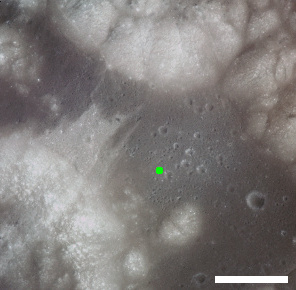
Mackin is a feature on Earth's Moon, a crater in Taurus–Littrow valley. Astronauts Eugene Cernan and Harrison Schmitt landed north of it in 1972, on the Apollo 17 mission, but did not visit it.
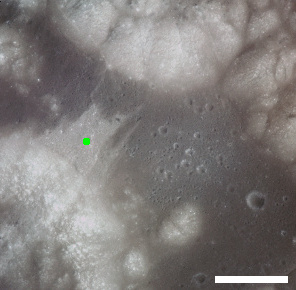
Lara is a feature on Earth's Moon, a crater in Taurus-Littrow valley. Astronauts Eugene Cernan and Harrison Schmitt visited it in 1972, on the Apollo 17 mission, during EVA 2. Geology Station 3 of the mission is located on the northeast rim of Lara.

Horatio is a feature on Earth's Moon, a crater in Taurus-Littrow valley. Astronauts Eugene Cernan and Harrison Schmitt drove the Lunar Roving Vehicle along its south rim in 1972, on the Apollo 17 mission, but did not stop.

Hess-Apollo is a feature on Earth's Moon, a crater in Taurus–Littrow valley. Astronauts Eugene Cernan and Harrison Schmitt landed north of it in 1972, on the Apollo 17 mission, but did not visit it. The astronauts referred to it simply as Hess during the mission.
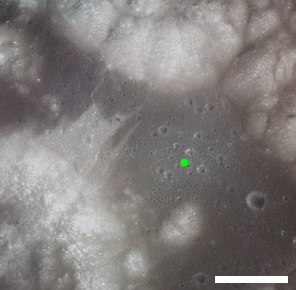
Emory is a feature on Earth's Moon, a crater in Taurus–Littrow valley. Astronauts Eugene Cernan and Harrison Schmitt landed north of it in 1972, on the Apollo 17 mission, but did not visit it.

Trident is a feature on Earth's Moon, a crater in Taurus-Littrow valley. Astronauts Eugene Cernan and Harrison Schmitt landed about 300 m north of its rim in 1972, on the Apollo 17 mission. They drove along the east rim of Trident during EVA 1 of the mission, in their rover.

Powell is a feature on Earth's Moon, a crater in Taurus–Littrow valley. Astronauts Eugene Cernan and Harrison Schmitt landed less than 1 km northeast of it in 1972, on the Apollo 17 mission, but they did not visit it.

Bowen-Apollo is a feature on Earth's Moon, a crater in Taurus-Littrow valley, located at the foot of the Sculptured Hills. Astronauts Eugene Cernan and Harrison Schmitt landed to the southwest of it in 1972, on the Apollo 17 mission. They referred to it simply as Bowen during the mission. It is located just east of Geology Station 8.

Henry is a feature on Earth's Moon, a crater in Taurus–Littrow valley, located at the foot of the Sculptured Hills. Astronauts Eugene Cernan and Harrison Schmitt landed to the southwest of it in 1972, on the Apollo 17 mission.
